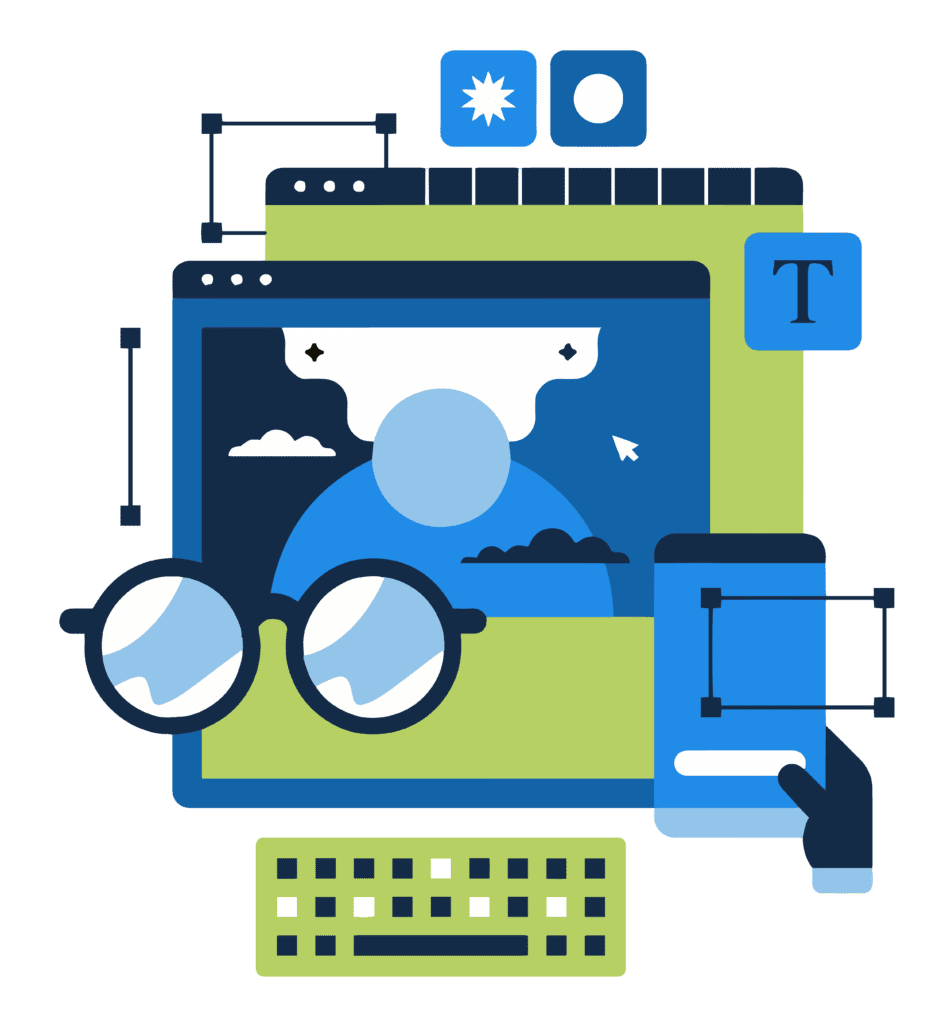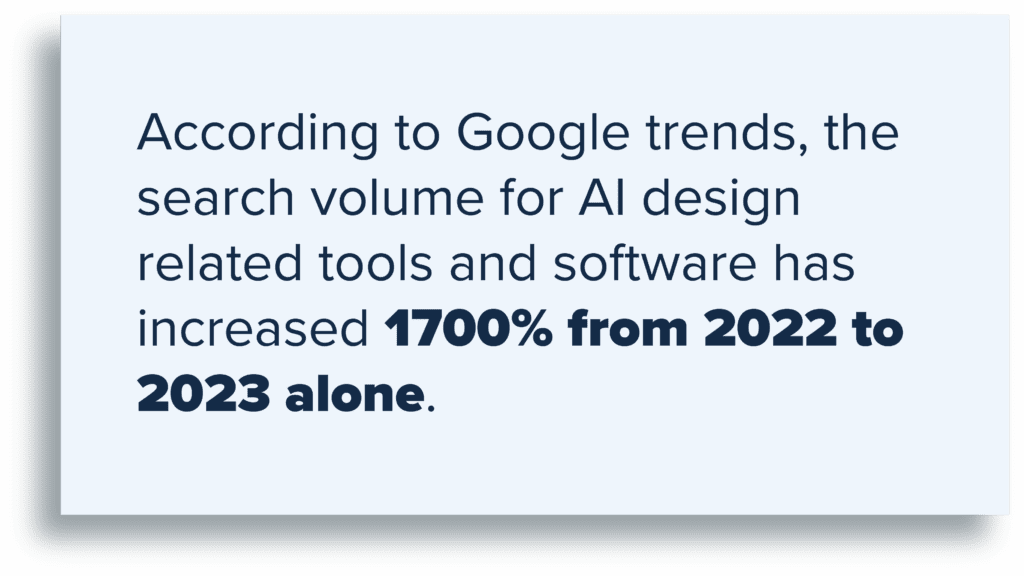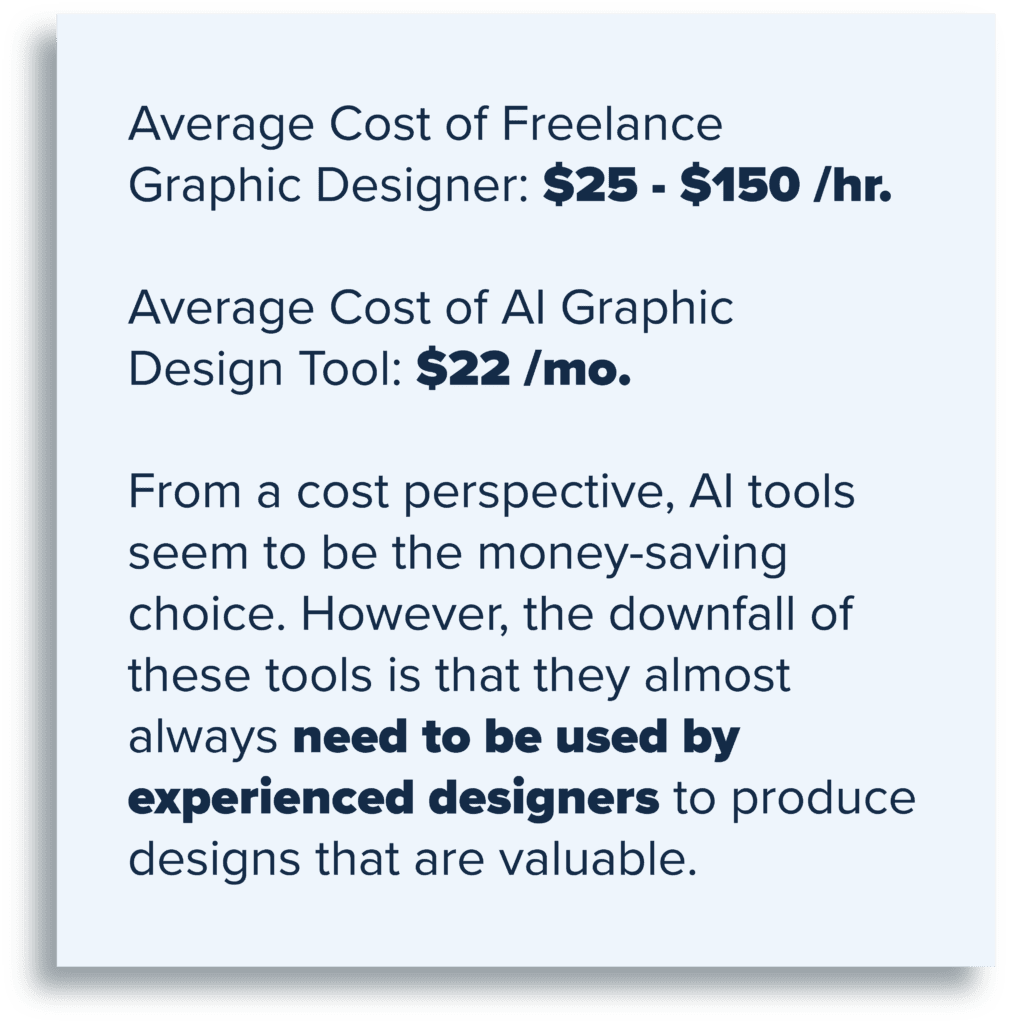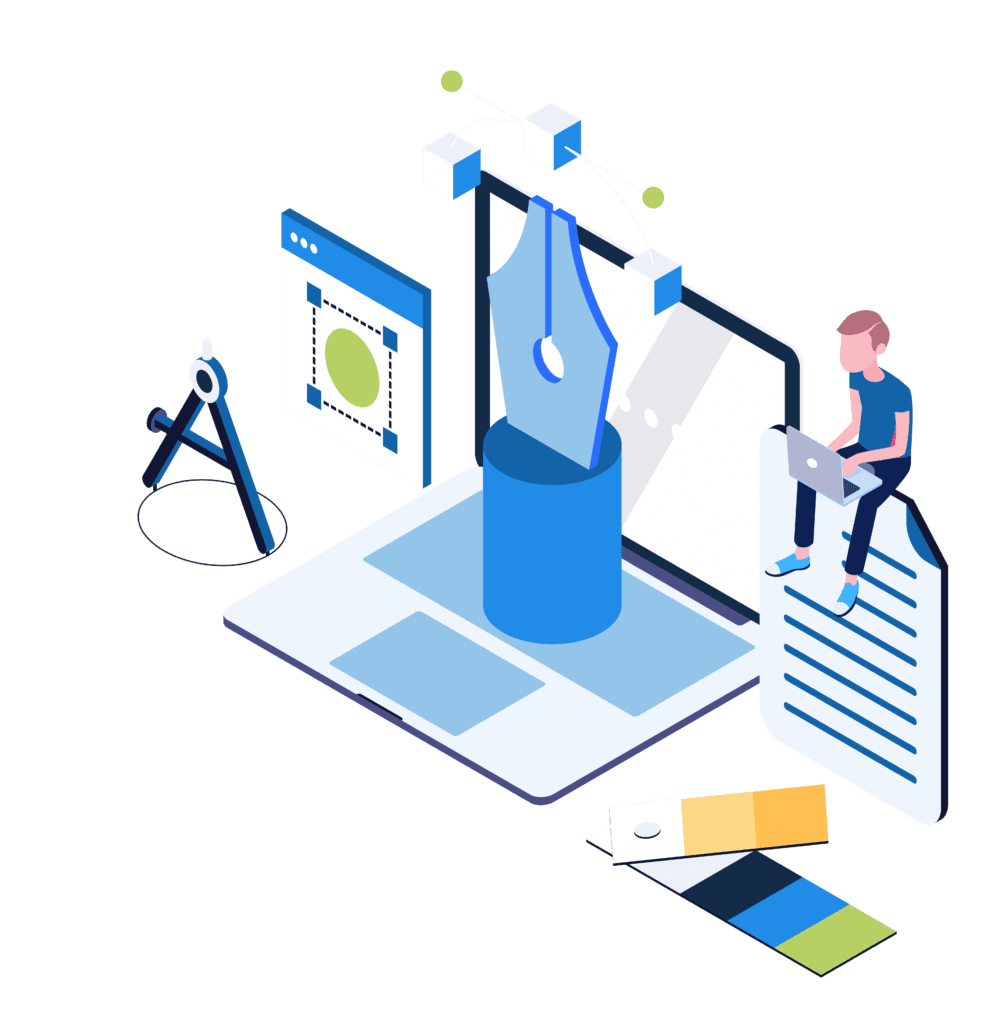
According to HubSpot, 93% of website designers have used an AI tool to help with development. The days of creating graphic designs with pencil and paper are over. The design community is turning to AI tools to increase productivity, reduce mistakes, and enhance the creative process. An example is the AI design tool Autodraw, which simplifies graphic design by transforming basic doodles into professional images using machine-learning algorithms.
AI may be transforming the graphic design industry, but it still doesn’t replace human designers. Here’s why.
Introduction to AI Graphic Design
AI graphic design is a revolutionary technology that uses artificial intelligence to create stunning visuals and automate the graphic design process. With AI graphic design tools, graphic designers can streamline their workflow, save time, and focus on high-level creative decisions. AI graphic design is not meant to replace human designers but rather to augment their skills and enhance their creative process.
The Rise of AI Graphic Design
Artificial intelligence has recently exploded into almost every tool online, but it has been evolving for the past few decades. Early iterations focused on completing more repetitive tasks like image manipulation, typography, and layout. Tools like Adobe Photoshop, Illustrator, and InDesign were the dominant players in graphic design for a long time. Although these programs are powerful and have been used to create some of the most iconic designs, they still require manual input from a designer.

Deep learning and neural networks have laid the groundwork for most of what we know today in graphic design. AI design tools can now process enormous amounts of data that were not previously possible. Designs from these tools are now based on user preferences and data, and they can still perform all the repetitive tasks they were designed to complete.
Canva and Midjourney are two popular AI-powered tools that help non-designers create visually appealing designs. An AI image generator can create high-quality, customizable images for various projects like logos and social media graphics.
How AI Graphic Design Works
AI graphic design tools use machine learning algorithms to analyze data and generate designs based on user input. These algorithms can be trained on vast amounts of data, including images, text, and other design elements. When a user inputs a design prompt or selects a template, the AI algorithm generates a design based on the training data. The user can then refine the design using various tools and features provided by the AI graphic design tool.
Current Applications of AI in Graphic Design
The future of AI in graphic design has seemingly unlimited potential. Below are some ways to use AI in the design process for the most impact.
Automation of repetitive tasks and mundane design elements
AI tools never get bored, and they never take a break. They are perfect for taking over repetitive mundane tasks that a human designer would never enjoy or want to do: adding patterns or textures, cropping images, removing the background from an image, and more.
The more tasks an AI tool can complete for a designer, the more time the designer has for critical thinking projects (which AI tools can’t handle well). For example, only a human can dissect a customer brief and ask pertinent questions to dig deeper into what the client truly wants or innovate solutions to a client’s project by piecing together multiple tools or designs.
Enhancing creativity through generative AI design
Generative AI is a transformative technology that enhances creativity and efficiency in graphic design. Some tools allow you to create full-resolution images from text input. All you have to do is type what you want to create, and within seconds, the tool will generate a high-resolution image based on your input. You won’t just get one image, either.
This is perfect for quickly creating an inspirational piece of art or experimenting with design ideas without drawing them out. Designers get to see a rough draft of an idea within seconds rather than brainstorming, outlining, drawing, and iterating manually.
Streamlining workflow and design production
Since an AI tool can handle multiple tasks simultaneously, you’ll be free to churn out more designs in less time. Generative AI tools enhance design capabilities by automating complex tasks, allowing users to easily manipulate images with text prompts. You could create multiple versions of the same design and compare them side-by-side to determine which works best.
You’ll save time and money when using an AI tool to help produce high-quality graphic design work. However, although AI tools are advanced, they still need human engagement to help guide results.
AI Graphic Design Tools
There are many AI graphic design tools available, each with its unique features and capabilities. Some popular AI graphic design tools include Adobe Firefly, Canva, Designs.ai, and Leonardo.Ai. These tools offer a range of features, including text-to-image generation, image editing, and design suggestions. AI graphic design tools can be used for various creative projects, including social media posts, logos, brochures, and more.
Strengths of AI Graphic Design
When experimenting with AI graphic design tools, you’ll notice they can complete some tasks better than others. A notable feature is the text-to-image generator, which allows users to input written prompts to create detailed and visually appealing images. Below are a few of the greatest strengths of an AI tool in design assistance.
Speed and efficiency in completing design tasks
No human can compete with an AI tool when it comes to speed and efficiency. An AI graphic design tool can complete a task in seconds that would take a human several minutes, hours, or even days. While you take some time off to enjoy the rest of your day, the AI tool runs in the background, ready to complete another task. An AI tool can generate results quickly as long as you know exactly what you want, so you don’t have to waste time on tedious tasks.
Ability to analyze large data sets and generate data-driven visuals
The amount of data being collected every day for the different tools we use is overwhelming. While it would take your enterprise several employees and several months to analyze that data, an AI tool does it in half the time. A graphic design tool run by AI can take massive amounts of data and analyze it to generate visuals that accurately represent the results. This is perfect for creating visualizations that better explain complex data sets for presentations, guides, training, etc.
Consistency and precision in executing design elements
AI tools can store and apply your brand’s color palette, typography, logo, and other design elements across different designs. This ensures that all your visuals maintain a uniform look and feel that aligns with your brand identity. The tools also have editing capabilities to automatically align, size, and crop elements to the perfect position.
Limitations of AI Graphic Design Tools

At this point, you may think you’ve found a cheaper replacement for your entire design team. But while there are many strengths to using AI graphic design tools, there are also limitations that prevent them from being able to replace a human designer.
Limitations of AI Graphic Design
While AI graphic design tools have revolutionized the design industry, they are not without limitations. One of the main limitations is the lack of human intuition and creativity. AI algorithms can generate designs based on data, but they may not always understand the nuances of human creativity. Additionally, AI graphic design tools may not be able to replicate the complexity and depth of human-designed graphics. However, these limitations are being addressed by ongoing research and development in the field of AI graphic design.
Lack of intuition and subjective judgment
All the work AI graphic design tools accomplish is based on set, predetermined instructions. This means they cannot think outside the box and develop creative solutions to a problem or unique ways of executing tasks. AI tools can only offer what has been programmed into them, limiting their capacity for creative work.
It also limits their capacity to judge whether something is good or bad. The tool knows what input it has been given but isn’t equipped to determine whether one design or edit is preferred over another. The process still requires human interaction to guide the tool to what the designer is trying to accomplish.
Inability to understand complex artistic concepts and emotions
Since AI tools lack human emotions, they can’t experience joy, sadness, excitement, or any other emotion. That means they can’t understand or replicate complex artistic concepts and emotions through visuals. AI tools cannot match the nuances, subtleties, and intricacies of human emotion with a design.
This is where human designers excel, as emotional intelligence is critical in communicating a compelling message through visuals. AI tools can’t tell if adding a certain color or image works better than another. That judgment is left to a human designer.
Difficulty in adapting to unique or unconventional design requirements
AI is fundamentally data-driven. It operates based on predefined algorithms and learns from patterns in existing data. While this allows AI to excel at tasks involving repetition and pattern recognition, it will struggle when asked to deviate from established norms.
Unique and unconventional design requirements often involve a deep understanding of the project’s context, such as cultural nuances, societal trends, and the specific needs and preferences of the target audience. These are areas where AI, despite its vast computational power, falls short.
Comparison Between AI Graphic Design and Human Graphic Design
If you need to optimize your workflow and want a tool that completes mundane tasks for you, AI graphic design software is the solution. However, you’ll still need human intervention to produce creative, innovative, and intuitive work. The ability of humans to understand subtleties within communication and give context to graphic design sets them apart from AI-generated content.
Humans can understand the exact needs of the clients and discuss specific ways to improve, while AI tools can only guess what you want and won’t be able to iterate on your designs. Your designs will lack emotion and cultural nuances when using AI tools only.
While the future of graphic design will inevitably involve AI, humans are still integral to creating great work.
The impact of AI on meeting client expectations

Where AI really falters is in matching a client’s expectations. The tool only provides results based on what you tell it, and finding the exact words and phrases to get what you want can take days. Relying on AI graphic design tools to deliver personalized and tailored designs will always lead to disappointment.
Humans are needed to create designs that look aesthetically appealing and meet your customers’ requests. You can’t rely on AI to facilitate communications about changes to a project or understand the client’s expectations. The responsibility to satisfy clients and create innovative designs that impress is still solely on the shoulders of your human designers.
Best Practices for Graphic Designers
To get the most out of AI graphic design tools, graphic designers should follow best practices. First, designers should understand the capabilities and limitations of the AI tool they are using. Second, designers should provide clear and concise input to the AI algorithm to ensure accurate results. Third, designers should refine and edit the AI-generated design to ensure it meets their creative vision. Finally, designers should use AI graphic design tools as a starting point for their design process, rather than relying solely on the AI output.
Invest in Human Graphic Design at Elevato
At Elevato, we are cultivating the perfect solution for emotionless AI-generated content. Our expert graphic designers are familiar with the latest AI technology but still use their human creativity and innovation to create original and unique designs.
We understand the importance of custom projects and meeting customer expectations, and we strive to make sure each project is produced with excellence. Talk with our team today and learn how we can help streamline your graphic design workflow for maximum efficiency and creativity.
